Notting Hill
| Notting Hill | |
| Middlesex | |
|---|---|
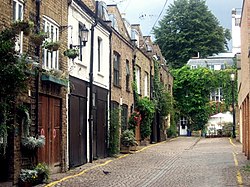 Notting Hill | |
| Location | |
| Grid reference: | TQ245805 |
| Location: | 51°30’35"N, 0°12’15"W |
| Data | |
| Post town: | London |
| Postcode: | W2, W10, W11 |
| Dialling code: | 020 |
| Local Government | |
| Council: | Kensington and Chelsea |
| Parliamentary constituency: |
Kensington |
Notting Hill is an affluent city village in Middlesex, deep within the conurbation, to the west of Westminster,
Notting Hill is known for being a cosmopolitan and multicultural neighbourhood, hosting the annual Notting Hill Carnival and Portobello Road Market.
From around 1870, Notting Hill had an association with artists.[1]
For much of the 20th century, the large houses were subdivided into multi-occupancy rentals. Caribbean immigrants were drawn to the area in the 1950s, partly because of the cheap rents, but were exploited by slum landlords like Peter Rachman and also became the target of white Teddy Boys in the 1958 Notting Hill race riots.
Then known for its slum housing, in the early 21st century, after decades of gentrification, Notting Hill has a reputation as an affluent and fashionable area, known for attractive terraces of large Victorian townhouses and high-end shopping and restaurants (particularly around Westbourne Grove and Clarendon Cross). A Daily Telegraph article in 2004 used the phrase "the Notting Hill Set"[2] to refer to a group of emerging Conservative politicians, such as David Cameron and George Osborne, who would become respectively Prime Minister and Chancellor of the Exchequer and were once based in Notting Hill.
Name
The origin of the name "Notting Hill" is uncertain[3] though an early version appears in the Patent Rolls of 1356 as Knottynghull,[4] while an 1878 text, Old and New London, reports that the name derives from a manor in Kensington called "Knotting-Bernes,", "Knutting-Barnes," or "Nutting-barns",[1] and goes on to quote from a court record during Henry VIII's reign that "the manor called Notingbarons, alias Kensington, in the parish of Paddington, was held of the Abbot of Westminster."
For years, the name was thought to be a link with Canute, but it is now thought likely that the "Nott" section of the name is derived from the Saxon personal name Cnotta,[5] so Cotting would mean 'Cnotta's children (or people)'.[6]
In G K Chesterton's The Napoleon of Notting Hill the accidental king, Auberon Quin, romanticallly suggests that the name was originally 'Nothing ill'.
History
Notting Hill was once a hamlet on rural land until the expansion of urban sprawl during the 19th century.
Potteries and Piggeries
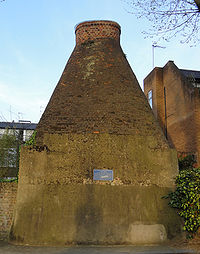
The area in the west around Pottery Lane was used in the early 19th century for making bricks and tiles out of the heavy clay dug in the area.[7] The clay was shaped and fired in a series of brick and tile kilns.[8] The only remaining 19th-century tile kiln in London is on Walmer Road.[9]
In the same area, pig farmers moved in after being forced out of the Marble Arch area. Avondale Park was created in 1892 out of a former area of pig slurry called "the Ocean". This was part of a general clean-up of the area which had become known as the Potteries and Piggeries.
19th-century development
The area remained rural until London's westward expansion reached Bayswater in the early 19th century. The Ladbroke family was Notting Hill's main landowner, and from the 1820s James Weller Ladbroke began to develop the Ladbroke Estate. Working with the architect and surveyor Thomas Allason, Ladbroke began to lay out streets and houses, with a view to turning the area into a fashionable suburb of the capital (although the development did not get seriously under way until the 1840s). Many of these streets bear the Ladbroke name, including Ladbroke Grove, the area's main north–south axis, and Ladbroke Square, London's largest private garden square.
The original idea was to call the district 'Kensington Park', and other roads (notably Kensington Park Road and Kensington Park Gardens) are reminders of this.

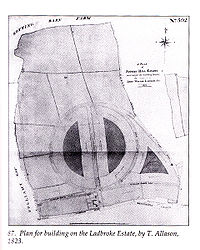
Ladbroke left the actual business of developing his land to the firm of City solicitors, Smith, Bayley (known as Bayley and Janson after 1836), who worked with Allason to develop the property. In 1823 Allason completed a plan for the layout of the main portion of the estate. This marks the genesis of his most enduring idea – the creation of large private communal gardens, originally known as "pleasure grounds", or "paddocks", enclosed by terraces and/or crescents of houses.
Instead of houses being set around a garden square, separated from it by a road, Allason's houses would have direct access to a secluded communal garden in the rear, to which people on the street did not have access and generally could not see. To this day these communal garden squares continue to provide the area with much of its attraction for the wealthiest householders.[10]
In 1837 the Hippodrome racecourse was laid out.[11] The racecourse ran around the hill, and bystanders were expected to watch from the summit of the hill. However, the venture was not a success, in part due to a public right of way which traversed the course, and in part due to the heavy clay of the neighbourhood which caused it to become waterlogged. The Hippodrome closed in 1841, after which development resumed and houses were built on the site. The crescent-shaped roads that circumvent the hill, such as Blenheim Crescent, Elgin Crescent, Stanley Crescent, Cornwall Crescent and Landsdowne Crescent, were built over the circular racecourse tracks. At the summit of hill stands the elegant St John's church, built in 1845 in the Early English Gothic style, and which formed the centrepiece of the Ladbroke Estate development.
The Notting Hill houses were large, but they did not immediately succeed in enticing the very richest Londoners, who tended to live closer to the centre of London in Mayfair or Belgravia. The houses appealed to the upper middle class, who could live there in Belgravia style at lower prices. In the opening chapter of John Galsworthy's Forsyte Saga novels, he housed the Nicholas Forsytes "in Ladbroke Grove, a spacious abode and a great bargain".[12] In 1862 Thomas Hardy left Dorchester for London to work with architect Arthur Blomfield; during this period he lived in Westbourne Park Villas. He immersed himself in the city's literary and cultural life, studying art, visiting the National Gallery, attending the theatre and writing prose and poetry. His first published story, "How I Built Myself a House", appeared in Chamber's Journal in 1865. Here he wrote his first―but never published―novel, The Poor Man and the Lady, in 1867, and the poem "A Young Man's Exhortation," from which Graham Greene took an epigraph for his own novel The Comedians. Arthur Machen (1863–1947), the author of many supernatural and fantastic fictions, lived at 23 Clarendon Road, Notting Hill Gate, in the 1880s; he writes of his life here in his memoirs Far Off Things (1922) and Things Near and Far (1923). His mystical work The Hill of Dreams (1907, though written ten years earlier) has scenes set in Notting Hill; it is here that the protagonist Lucian Taylor encounters the beautiful bronze-haired prostitute who will later connive at his death.
Early to mid-20th century
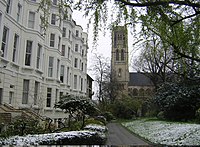
The reputation of the district altered over the course of the 20th century. As middle-class households ceased to employ servants, the large Notting Hill houses lost their market and were increasingly split into multiple occupation. During the Blitz a number of buildings were damaged or destroyed by the Luftwaffe, including All Saints' Church, which was hit in 1940 and again in 1944. In the postwar period the name Notting Hill evoked a down-at-heel area of cheap lodgings, epitomised by the racketeering landlord Peter Rachman and the murders committed by John Christie in 10 Rillington Place, since demolished. The area to the north east, Golborne, was particularly known for being, in the words of Charles Booth, "one of the worst areas in London".[13] Southam Street in Kensal Green had 2,400 people living in 140 nine-roomed houses in 1923, and the slum children from this street were documented in the 1950s photographs of Roger Mayne.
In late August and early September 1958, the Notting Hill race riots occurred. The series of disturbances are thought to have started on 30 August when a gang of white youths attacked a Swedish woman, Majbritt Morrison, who was married to a West Indian man (Raymond Morrison), following a previous incident in Latimer Road tube station.[14] Later that night a mob of 300 to 400 white people, including many "Teddy Boys", were seen on Bramley Road attacking the houses of West Indian residents. The disturbances, racially-motivated rioting and attacks continued every night until they petered out by 5 September.
The dire housing conditions in Notting Hill led Bruce Kenrick to found the Notting Hill Housing Trust in 1963, helping to drive through new housing legislation in the 1960s and found the national housing organisation Shelter in 1966.[15] Nos 1–9 Colville Gardens, now known as Pinehurst Court, had become so run down by 1969 that its owner, Robert Gubay of Cledro Developments, described conditions in the buildings as "truly terrible".[16]
The slums were cleared during redevelopment in the 1960s and 1970s when the Westway Flyover and Trellick Tower were built. It is now home to a vibrant community, mainly Mediterranean Spanish and Moroccan, together with Portuguese.[17]
Late 20th-century gentrification
By the 1980s, single-occupation houses began to return to favour with families who could afford to occupy them, and because of the open spaces and stylish architecture Notting Hill is today one of London's most desirable areas.[18] Several parts of Notting Hill are characterised by handsome stucco-fronted pillar-porched houses, often with private gardens, notably around Pembridge Place and Dawson Place and streets radiating from the southern part of Ladbroke Grove, many of which lead onto substantial communal gardens. There are grand terraces, such as Kensington Park Gardens, and large villas as in Pembridge Square and around Holland Park. There is also new construction of modern houses tucked away on backland sites.[19]
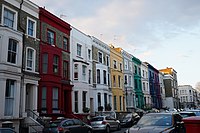
Since at least 2000, independent shops in Portobello such as Culture Shack have lost out to multinational standardised chains such as Starbucks.[20] In 2009, Lipka's Arcade, a large indoor antiques market, was replaced by the high-street chain AllSaints.[21] Reflecting the increasing demise of one of the most culturally vibrant parts of the conurbation, the 2011 Census showed that in the borough of Kensington and Chelsea, in which Notting Hill is situated, the number of Black or Black British and White Irish residents, two of the traditionally largest ethnic minority groups in Notting Hill, declined by 46 and 28 percent respectively in ten years.[22]
The district adjoins two large public parks, Holland Park and Kensington Gardens, with Hyde Park within a mile to the east. The gentrification has encompassed some streets that were among the 1980s' most decrepit, including the now expensive retail sections of Westbourne Grove and Ledbury Road, as well as Portobello Road's emergence as a top London tourist attraction and Chamberlayne Road as a local shopping street with its boutique independent shops. Notting Hill has a high concentration of restaurants, including the two Michelin-rated The Ledbury and Core by Clare Smyth.
Carnival
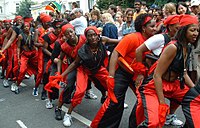
Notting Hill Carnival is an annual event in August, over two days (Sunday and the following bank holiday). It has continuously taken place since 1965.[23] It is led by members of the Caribbean population, many of whom have lived in the area since the 1950s. The carnival has attracted up to 1.5 million people in the past, putting it among the largest street festivals in Europe.
It attracted press attention in 1976 for clashes with the police,[24] which occurred in 1976 at the conclusion of the Notting Hill Carnival after police arrested a pickpocket and a group of black youths came to his defence. The disturbance escalated and more than 100 police officers were injured.[25] Further incidents continued for a few years, but receded for several decades, until 2008 when approximately 500 youths clashed with police on the Monday.
In 2003 Carnival was run by a limited company, the Notting Hill Carnival Trust Ltd. A report by the London Development Agency on the 2002 Carnival estimated that the event contributes around £93 million to the London and British economy.
IN literature and popular culture
Notting Hill provides the setting for novels by G.K. Chesterton (The Napoleon of Notting Hill), Colin MacInnes (Absolute Beginners), Michael Moorcock (the Jerry Cornelius quartet), R. C. Sherriff (The Hopkins Manuscript), and Alan Hollinghurst (The Line of Beauty). Dan Waddel's The Blood Detective is a murder novel set in the past and present - featuring Notting Dale.
The area's newer, wealthy residents are satirised in Rachel Johnson's novel Notting Hell (2006) set in grand houses surrounding a fictional communal garden. Sam Selvon's 1956 novel The Lonely Londoners set in Notting Hill portrays the lives of Caribbean immigrants making their way in post-War London.
The area is also the setting of films such as The Knack …and How to Get It (1965), Lava (2001), and Paddington (2014).
Most famously the 1999 romantic comedy Notting Hill, starring Julia Roberts and Hugh Grant, was set here.
A film set in the same streets but showing a different story of the area is Pressure (1976), by Horace Ové, examining the experience of those of Caribbean descent in 1970s Notting Hill including police brutality and discrimination.
Outside links
| ("Wikimedia Commons" has material about Notting Hill) |
- Hudson, Jennifer: "The forgotten black history of London's famous Notting Hill neighbourhood", mic.com, 31 October 2018.
References
- ↑ 1.0 1.1 [1] 'Notting Hill and Bayswater', Old and New London: Volume 5 (1878), pp. 177-88.
- ↑ Watt, Nicholas (28 July 2004). "Tory Bright Young Things". The Guardian (London). https://www.theguardian.com/politics/2004/jul/28/conservatives.uk1. Retrieved 18 February 2010.
- ↑ "Notting Hill: Mandelson in good company". BBC News. 22 December 1998. http://news.bbc.co.uk/1/hi/uk/240416.stm. Retrieved 17 February 2009.
- ↑ "Kensington and Chelsea". http://www.britannica.com/EBchecked/topic/314954/Kensington-and-Chelsea. Retrieved 17 February 2009.
- ↑ Anderson, Sarah (21 June 2007). "Inside Notting Hill". The Times (London). http://travel.timesonline.co.uk/tol/life_and_style/travel/holiday_type/travel_and_literature/article1967240.ece. Retrieved 17 February 2009.
- ↑ "-ing". http://www.glaucus.org.uk/-ing.htm. Retrieved 17 February 2009.
- ↑ Hardman, Josh (18 August 2018). "Community Responses to Infrastructure Projects in Notting Dale". https://londongeographies.com/infrastructure/community-responses-to-infrastructure-projects-in-notting-dale.
- ↑ "London streets - Pottery Lane", BBC London, Template:Webarchive
- ↑ "Notting Hill". http://www.london-footprints.co.uk/wknottinghillroute.htm.
- ↑ @[2]
- ↑ McConnell, Sara (6 February 2006). "Notting Hill on foot". The Times (London). http://travel.timesonline.co.uk/tol/life_and_style/travel/destinations/england/article727749.ece. Retrieved 20 May 2010.
- ↑ John Galsworthy, The Man of Property, Chapter 1, published 1906.
- ↑ "One thousand years of Goldborne". Golborne Life. http://www.golbornelife.co.uk/golbornehistory.html. Retrieved 17 February 2009.
- ↑ BBC News: Long history of race rioting, British Broadcasting Corporation, 28 May 2001.
- ↑ "Reverend Bruce Kenrick", Nottinghill Houing, 22 January 2007.
- ↑ Jan O'Malley The Politics of Community Action in Notting Hill, Spokesman Press, 1977
- ↑ Maggoch, Tom (20 December 2006). "Exotic eats in West London". The London Paper. http://www.thelondonpaper.com/cs/Satellite/london/food/article/1157140145760?packedargs=suffix%3DSubSectionArticle. Retrieved 17 February 2009.
- ↑ "Proud to be a Notting Hill Tory". BBC News. 6 October 2005. http://news.bbc.co.uk/1/hi/uk_politics/4314926.stm. Retrieved 7 June 2009.
- ↑ "Light House". http://us.archello.com/en/project/light-house-2. Retrieved 24 January 2018.
- ↑ Braid, Mary (20 November 2005). "Gap? Starbucks? On Portobello Road, darling?". The Independent. https://www.independent.co.uk/news/uk/this-britain/gap-starbucks-on-portobello-road-darling-516154.html. Retrieved 8 December 2013.
- ↑ "Dealers mobilise over threat to Portobello". Antiques Gazette. 1 February 2010. http://www.antiquestradegazette.com/news/2010/feb/01/dealers-mobilise-over-threat-to-portobello. Retrieved 8 December 2013.
- ↑ "Census 2011: Truth where you live". 13 December 2012. https://www.theguardian.com/uk/interactive/2012/dec/13/census-2011-truth-where-you-live-interactive. Retrieved 8 December 2013.
- ↑ 1Xtra – Black History. "1965". BBC News. https://www.bbc.co.uk/1xtra/blackhistory/years/1965.shtml. Retrieved 17 February 2009.
- ↑ Griffiths, Emma (25 August 2006). "Remembering the Notting Hill riot". BBC News. http://news.bbc.co.uk/1/hi/england/london/5275542.stm. Retrieved 17 February 2009.
- ↑ "Notting Hill Carnival ends in riot". BBC News. 30 August 1976. http://news.bbc.co.uk/onthisday/hi/dates/stories/august/30/newsid_2511000/2511059.stm. Retrieved 7 June 2009.
